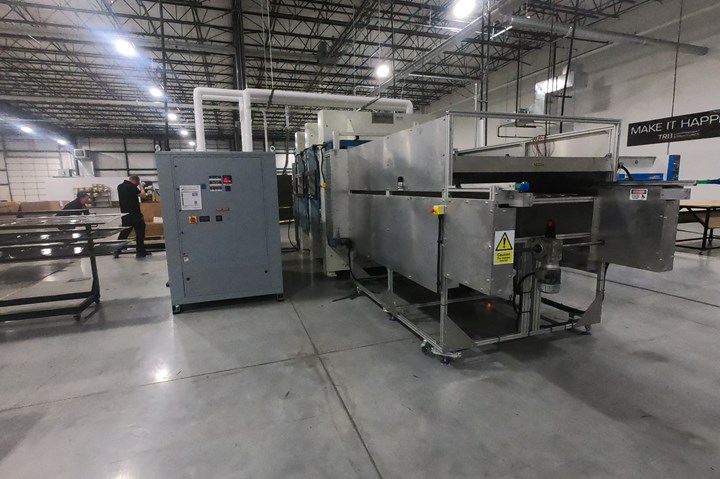TRB Lightweight Structures develops under-vehicle protection plates for electric vehicles
Plates are composed of a sandwich construction of advanced materials and toughened TRB resins for doubled impact absorption rates and halved weight.

TRB’s fast press cure (FPC), developed specifically for thermoset materials. Photo Credit: TRB Lightweight Structures
TRB Lightweight Structures (TRB, Huntingdon, U.K.) has developed a composite under-vehicle protection plate that is reported to dramatically improves impact absorption while decreasing weight. These panels have been created from a combination of materials and a proprietary, toughened TRB resin, using a manufacturing process that enables production at high volume; this cost-effective process, which was developed in parallel with this new solution, is now operating in both North America and the U.K., TRB says.
The protection plates use a sandwich construction of advanced materials, layered intelligently to provide varying impact absorption strengths depending on location. Testing has shown impact absorption rates that are typically doubled compared with best-in-class steel solutions, while halving the weight. TRB says the plates can be painted although, unlike steel, paint is not required for corrosion protection, while the low weight construction simplifies installation and replacement.
“Skateboard chassis designs require better battery protection for both on and off-road vehicles,” says Richard Holland, managing director of TRB Lightweight Structures. “Our approach leverages decades of knowledge in the development and testing of materials and manufacturing methods, resulting in a cost-effective solution for automotive components that decreases weight and increases performance.”
TRB will be showcasing its products and technology at The Battery Show Europe in Stuttgart, Germany, starting on November 30th, 2021.
Related Content
-
SMC composites progress BinC solar electric vehicles
In an interview with one of Aptera’s co-founders, CW sheds light on the inspiration behind the crowd-funded solar electric vehicle, its body in carbon (BinC) and how composite materials are playing a role in its design.
-
Composites end markets: Automotive (2025)
Composites manufacturing intelligence drives circular economy solutions as automotive industry balances technical demands with sustainability mandates.
-
Moving toward sustainable automotive parts manufacturing
How can the automotive supply chain prepare for future sustainability requirements? Tier 1 Kautex Textron discusses emissions reduction, design for circularity and transition to recycled/bio-based plastics.



